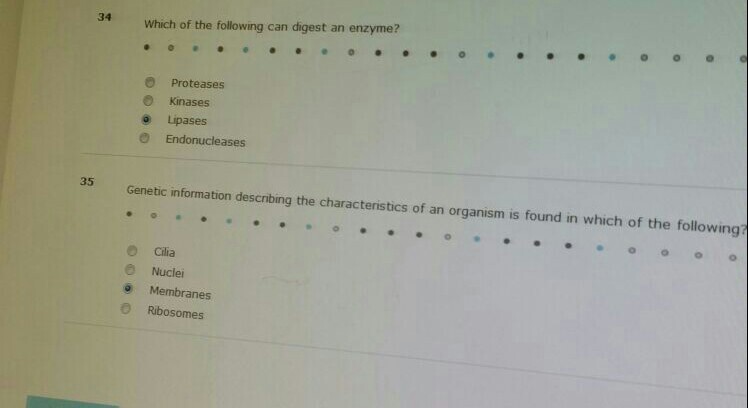Question

Asked By CrystalWaves53 at
Answered By Expert
Todd
Expert · 1.5k answers · 1k people helped
Step 1/2
Answer 34. :- Proteases
• can digest enzymes because proteases degrade protein and enzymes are proteins.
• Proteases are enzymes that can digest other enzymes. They are specifically responsible for breaking down proteins, including other enzymes, into their constituent amino acids. So, the correct answer is: protease
Explanation:
A group of enzymes called proteases are capable of digesting or dissolving proteins into their individual amino acid constituents. The regulation of cellular activities, the digestion of food proteins, and the elimination of damaged or unneeded proteins are only a few biological processes that depend on the proteolysis process. Proteases are the enzymes that are specialized in the digesting of other enzymes in the context of the alternatives offered, making them crucial for the upkeep and control of a variety of biochemical pathways within living organisms.
Step 2/2
• 35. Nuclei
because DNA is located in the nucleus of the cells that contain genetic information.
• Nuclei (plural: nucleus) contain genetic data that describes an organism's features. In eukaryotic cells, the nucleus is a membrane-bound organelle that houses the DNA, which carries the genetic material in charge of an organism's traits and characteristics. On the other hand, membranes are lipid-based structures that encapsulate diverse cell components but do not contain genetic information, whereas ribosomes are cellular structures involved in protein synthesis.
Explanation:
The cell nuclei of an organism contain the majority of the genetic material defining its traits. In eukaryotic cells, the nucleus is a key organelle where DNA is stored and arranged. The instructions required for an organism's growth, operation, and inherited features are encoded in its DNA. The nuclei's genetic material controls protein synthesis and is crucial to the biology and qualities of the organism as a whole, including its physical features, metabolism, and genetic makeup.
Final Answer
•According to the response, proteases are enzymes created especially to disassemble proteins, including other enzymes, into their individual amino acids.
These enzymes are necessary for a number of biological tasks, including the regulation of cellular processes and the breakdown of dietary proteins.
• The query concerned cellular biology's nucleus. The genetic material for the cell is kept in the nucleus, a membrane-bound organelle present in eukaryotic cells. This material is called DNA (deoxyribonucleic acid). The genetic code that specifies an organism's traits and characteristics is carried by this DNA.
🧑🏫 More Questions
👉 Interested in exploring further?
Chrome Extension
1. Search answers from our 90+ million questions database.
2. Get instantly AI Solutions powered by most advanced models like GPT-4, Bard, Math GPT, etc.
3. Enjoy one-stop access to millions of textbook solutions.
4. Chat with 50+ AI study mates to get personalized course studies.
5. Ask your questions simply with texts or screenshots everywhere.